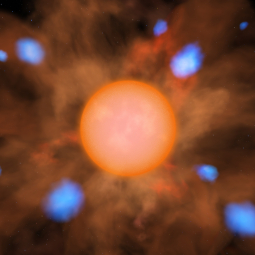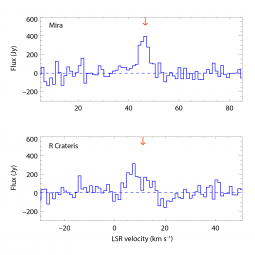By David Neufeld & Joan Schmelz
Paper:
Terahertz Water Masers. II. Further SOFIA/GREAT Detections Toward Circumstellar Outflows, and a Multitransition Analysis
Neufeld, David A., et al., 2021/01, ApJ, 907, 42.
Fundamental astrophysical applications of maser amplification include tracing the structure and rotation of the Milky Way galaxy, probing the molecular accretion disks that feed black holes in active galaxies, and constraining the Hubble constant using masers as geometrical distance estimators. Key to these discoveries are the extraordinarily high intensities in specific molecular transitions -- most notably the 1968 discovery of the 22 GHz transition of water vapor in the radio band -- and subsequent observations with Very Long Baseline Interferometry that reveal gas motions at the highest spatial resolution.
While maser amplification must be carefully engineered in the laboratory, it can occur entirely naturally in low-density astrophysical environments. Over the half-century following the discovery of 22 GHz water masers, observations at ever higher frequencies have revealed the maser phenomenon in several additional H 2 O transitions. These include several lines in the 300 – 500 GHz range detected from ground-based observatories at dry, high-altitude sites; at 621 and 970 GHz detected with the Herschel Space Observatory; and at 1.296 THz detected by SOFIA in 2016 toward three oxygen-rich evolved stars, W Hydrae, U Herculis, and VY Canis Majoris, as well as one star forming region, NGC 7538-IRS1. Based upon a model for the circumstellar envelope of W Hydra, researchers estimated that stimulated emission was responsible for ~85% of the observed 1.296 THz line emission, thus confirming that this transition may be properly described as a terahertz-frequency maser.
Recent observations with the GREAT instrument on SOFIA detected the 1.296 THz water maser transition in the outflowing circumstellar envelopes of two additional stars: Mira, a pulsating asymptotic giant branch star, and R Crateris, a semi-regular variable star. Researchers combined these measurements with ground-based observations of multiple lower frequency transitions of water. Such multitransition studies, which are critical for understanding the physical mechanism responsible for creating the population inversions that enable maser amplification, benefit from careful coordination because the maser fluxes can be highly variable. This entailed near-simultaneous observations at three observatories: SOFIA, the 100 m Effelsberg radio telescope in Germany used to observe the 22 GHz transition, and the APEX telescope in Chile used to observe other millimeter and submillimeter transitions.
The researchers combined these multiwavelength data and interpreted them using an excitation model. For each star, the model includes an estimate of how the gas temperature and density vary within the outflow, then computes the maser fluxes that are expected as a function of the assumed abundance of water vapor. In this model, the population inversions that enable maser amplification arise quite naturally from the combined effects of spontaneous radiative decay and collisional excitation in inelastic collisions between water molecules and molecular hydrogen (the dominant constituent of the gas); with the exception of one submillimeter maser transition, the model correctly predicts which transitions will be significantly inverted. Moreover, a quantitative comparison between the observed line fluxes and the model predictions allowed the water abundance to be estimated. For the five circumstellar outflows with terahertz-frequency maser detections, the implied water abundances fall in a rather narrow range, 1.4-2.5 × 10 –4 water molecules per hydrogen molecule. These values are broadly consistent with the expectation that water vapor and carbon monoxide will be the primary reservoirs of oxygen within such outflows.
Thus, the latest SOFIA observations of terahertz water masers, in combination with ancillary data obtained from ground-based observatories, have yielded a consistent picture that explains well the water maser phenomenon in circumstellar outflows.

